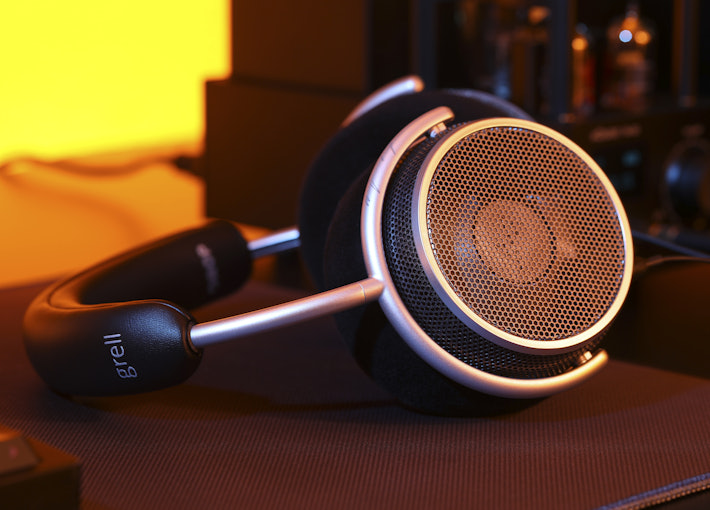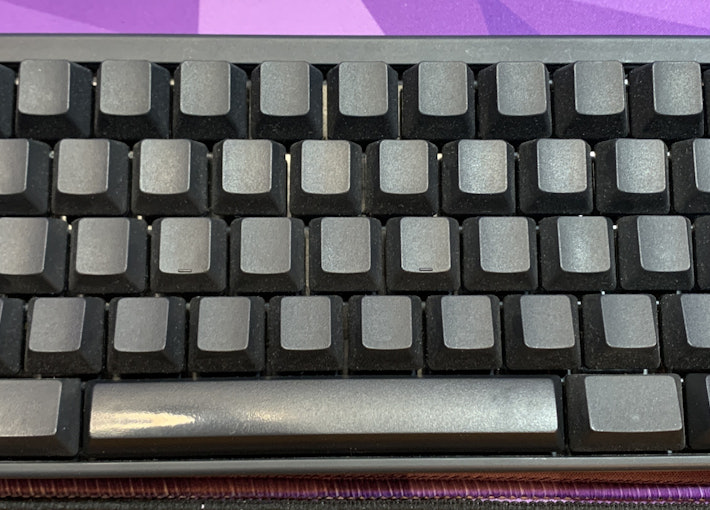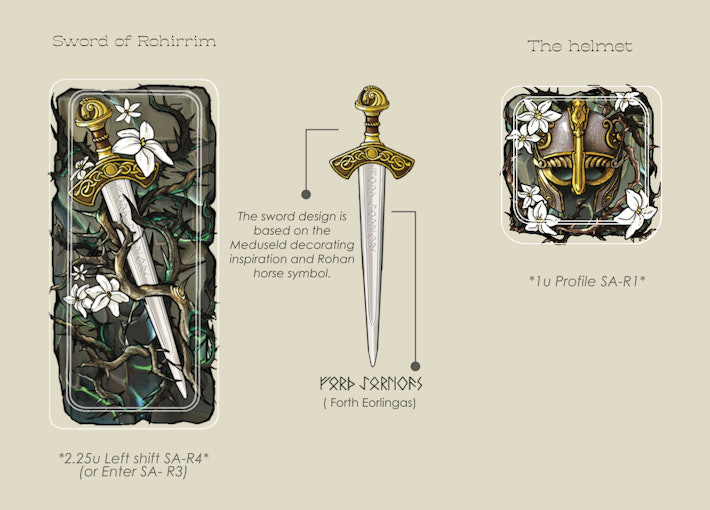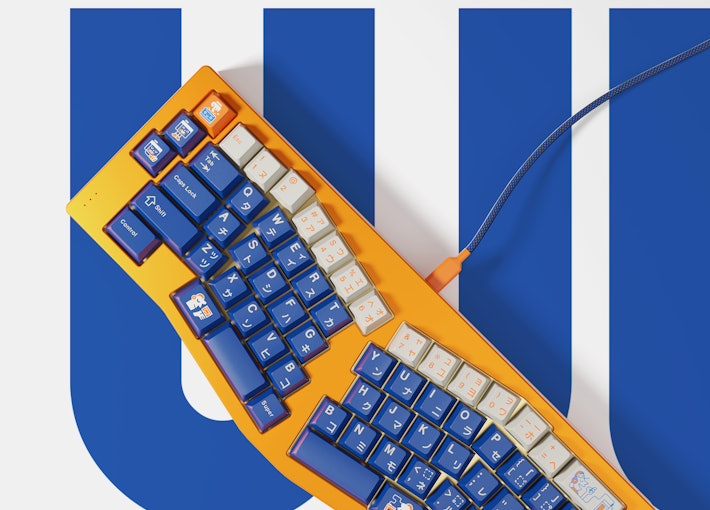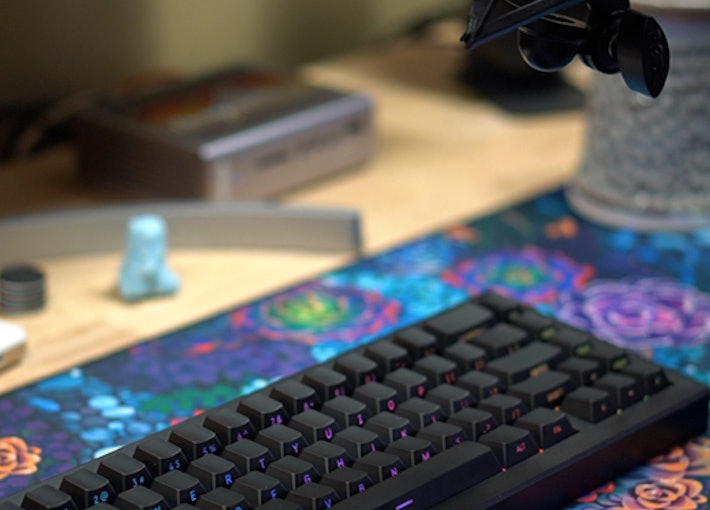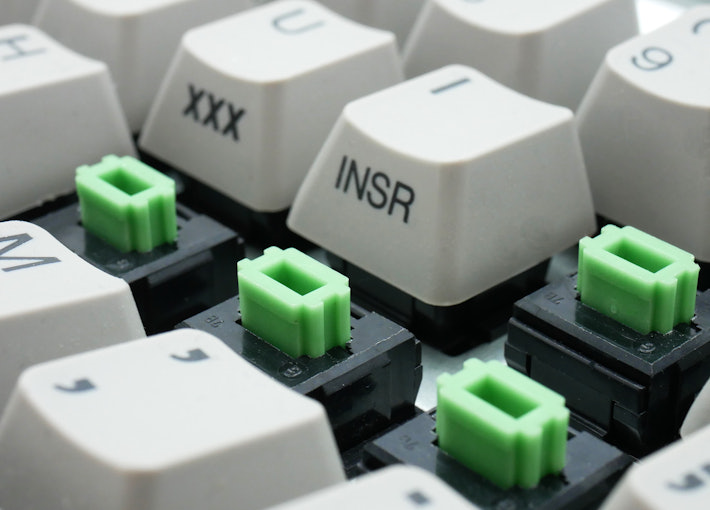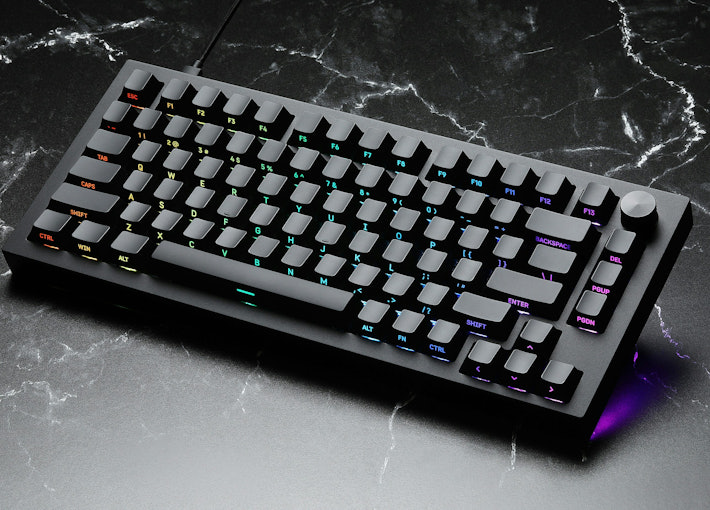Click to view our Accessibility Statement or contact us with accessibility-related questions





















Drop Hub

Drop+MechKeys
4399
Jun 25, 2024
Introducing Bees.Keys, designer duo behind DCD Hundred Acres
With the launch of DCD Hundred Acres imminently on the horizon, we wanted to introduce the designers of this fantastic set to the Drop community! Welcome Bees.Keys, and thank you both for so generously giving us your time to chat about yourselves, your process, and the Hundred Acres keycap set! For those unfamiliar, Bees.Keys is a team made up of Beesley and Cthalupa - both fantastic designers and a joy to speak with.
Without further ado, let's get things started!
Tell us a bit about yourself and your history - relevant to mech keys or not. Where are you from, what is your “day job”, what are your other hobbies and interests aside from keyboards?
[Beesley]
I’m from the UK, and my day job is producing marketing renders for mechanical keyboards and keycaps. I have always had a passion for CGI since I was kid, getting a subscription to 3D World magazine for my 10th birthday.
Other hobbies? What are other hobbies? I’m lucky enough to enjoy doing something for work so much...

Drop+MechKeys
4399
May 21, 2024
Drop + Bees.Keys DCD Hundred Acres Keycap Set
Winnie-the-Pooh - a story, characters, and setting loved by many across the globe. Most of us grew up with at least some exposure to this lovable bear and his woodland friends. Personally, the Hundred Acre Wood takes me back to a simpler time in life—a time of whimsy and wonder.
Bees.Keys shares this appreciation and affection for Pooh Bear and friends, going as far as designing a keycap set around the characters and themes. One look at the set shows their dedication and attention to detail. From the font to period-accurate depictions of characters to elaborate desk mat designs, this is as faithful a tribute as you’ll find.
We hope you’ll join us on this nostalgic journey through the Hundred Acre Wood when the set launches later this month. Hit Request to be notified!

Drop+Audiophile
3436
May 7, 2024
A Look Inside the Drop + Grell OAE1 signature
Our latest collaboration with Axel Grell, the Drop + Grell OAE1 signature headphones, will be launching on Thursday, May 9th!
As one final reveal in advance of the big launch, we wanted to highlight a recent interview between Axel Grell and Head-Fi where Axel dives into the science and design behind the OAE1 headphones.
If you haven't followed the Drop + Grell OAE1 story thus far, enjoy the journey from Story 1 - How the Drop + Grell Headphones Were Conceived.
What are you most excited for in the OAE1?
cobertt
22
May 7, 2024
State of the Hobby 2024
A brief reflection and look at how far our community has come since joining.
I’ve been in the mechanical keyboard hobby for a very long time. It started as a high school student’s search for a keyboard for writing novels back in the 2008-2009 school year. I thought I wanted to be an author and I felt I needed a keyboard that I could sit down to at my desk and just write. After researching, joining forums, and saving money, I made my first purchase in the hobby, a blank black Happy Hacking Keyboard Professional 2. I still own this keyboard and while it is heavily modded now, it remains one of my all-time favorites.
My HHKB Pro2 with MitchCapped Accents
Many people would have stopped there, but keyboards became a hobby. I enjoyed learning about them, and early on, I enjoyed hunting for them in thrift shops. I would dig through bins at Goodwill and Salvation Army while popping keycaps off with paperclips looking for mechanical switches. I searched for a birthday Model M...

dovenyi
61
Apr 30, 2024
What is SpaceFN and why you should give it a try
The SpaceFN concept - setting up your space key as a layer switch when held - is probably one of the most useful tweaks in the keyboard hobby. Let me explain how it works.
My SpaceFN article on kbd.news made some rounds recently - quite surprisingly given the age of this concept. This piece you're reading is a condensed version of the full post. If you're left with unanswered questions, you'll most likely find the info you're looking for in the original write-up.
On my imaginary top list of the most useful keyboard features, tweaks and hacks, SpaceFN would deserve a podium finish for sure. But what makes it so special?
In short: SpaceFN is easy to implement, easy to learn, costs nothing, can be used with any keyboard, and can improve your productivity instantly.
I will list its benefits below, but can state right at this point that the SpaceFN concept, setting up your space key as a layer switch when held, is clearly one of the most useful tweaks in the keyboard hobby....

dvorcol
5393
Apr 23, 2024
Support for Alternative Layouts
This is a summary of how alternative layouts have been supported by kits such as Colevrak and Homing. It is not a discussion of alt layout performance and development, but if that interests you I highly recommend starting with Pascal Getreuer’s A guide to alt keyboard layouts (why, how, which one?). It’s a concise and comprehensive overview with links to some great sites that go deeper. He also has a separate Links about keyboards page. The Keyboard layouts doc he recommends explains layout goals and metrics in detail, summarizing the alt layouts discussed here as well as more than one hundred others.
Sculpted-profile
The majority of custom keycap sets are sculpted-profile (Cherry, SA, MT3, KAT, etc. - more on profiles generally here) so let’s start there. Because each row has a unique keycap shape, alt layouts require a unique keycap for each legend that moves off its QWERTY row.
At first there were two
The Dvorak layout was patented in 1936 by August Dvorak & William L....
ThereminGoatMK
429
Apr 17, 2024
Do I Need to Lube My Keyboard Switches?
Figure 1: Sometime around here is a good time to ask that question...
If you’re new to the mechanical keyboard hobby, I have no doubt that planning your first keyboard build is a bit of a daunting task. To be entirely honest with you, it’s only a tiny bit less daunting for your second or even third keyboard builds should you stay around a little while longer. You’ve got the keyboard itself to worry about, stabilizers, keycaps, and even switches on top of all of the intangible marks you want your dream keyboard to hit. Switches are especially daunting right out of the gate as there’s just so many options out there to pick from – each with their own unique specifications, manufacturers, and more. Yet, in spite of all of these differences between switches, time and time again I find people always asking about lubing switches as one of their chief concerns when it comes to picking some up. With countless numbers of content creators talking about lubing switches, its no...

HoffmanMyster
3110
Apr 10, 2024
From Art to Artisan
Before launching any product, there are many designs, concepts, and ideas that pass between teams before arriving at a final design which makes its way to your computer screen and, eventually, desk. This is no more true than when considering possibly the most "art"-forward aspect of the mechanical keyboard hobby—artisan keycaps. It should be obvious that a lot of planning and artistry goes into crafting these literal pieces of art. We don't often get a chance to see behind the curtain, though. So, let's take a closer look at the upcoming Drop + Dwarf Factory Lord of the Rings Rohan Artisan Keycaps.
Before any resin is spilled, Middle Earth (the entity that licenses the Lord of the Rings IP) needs to approve the concepts based on concept art provided by Dwarf Factory. We connect with DF to coordinate on the topic and subject matter—in this particular case, additional Rohan-themed designs—to be sure that the concepts match with overall direction, whether that be pairing up with a...

Drop+MechKeys
4399
Apr 10, 2024
Mr. Bingo's Design Process and Inspiration
If you haven't seen the first part of our interview series with Mr. Bingo, be sure to check that out for an introduction to the designer himself. We're picking things up here with part two, where Mr. Bingo shares some of his design process and how he draws inspiration for his designs!
Before we dive in—we want to express another huge thank you to Mr. Bingo for taking the time to answer all of our questions here. It's always fascinating to get a peek behind the curtain and we're very appreciative for the opportunity.
Do you have a process for gathering your potential ideas, and culling down to workable concepts that you select designs to move forward with and take to the community? Would you be able to share a bit about what goes into those decisions?
I feel that I am a designer who likes to have physical things and not digital. So when it comes to making a set and already have the idea, I look for things physically, for example, in the matcha set, I did a lot of...

Drop+MechKeys
4399
Apr 9, 2024
Introducing Mr. Bingo, Retro-Inspired Designer
It is with great pleasure that we are able to formally introduce Mr. Bingo by way of an interview! Thank you so much for taking the time to answer all of our questions and allow us to peer inside your process a bit.
For those of you who aren't familiar with Mr. Bingo's past work yet, he's the brains behind GMK Cream Matcha and GMK Cubed, as well as many renders in support of other projects across the hobby.
He is of course also the designer behind DCD WLK-MN, his latest project inspired by a love of retro gadgets. So, without further ado, let's get to know Mr. Bingo!
We’d love to hear a little bit about yourself and your history - relevant to mech keys or not. Where are you from, what is your “day job”, what are your other hobbies and interests aside from keyboards?
Hey, well my day job is to design and do renders for a company that makes keyboards and gaming products. So I live from this hobby everyday! I also have other small hobbies that I'm just starting right...

HoffmanMyster
3110
Apr 9, 2024
DCX vs DCD vs DCL - Drop’s Keycap Profiles Explained
We’ve covered the basics of keycap profiles before—spherical/cylindrical, sculpted/uniform, etc. One thing that has come up more and more over the years as we’ve expanded our portfolio of offerings here at Drop is the distinction between some of our similar profiles. Specifically, what is the actual difference between DCX, DCD, and DCL?
Cylindrical Profiles
To recap the previous article on the topic, one of the most basic ways to separate various keycap profiles is by shape (cylindrical, spherical, or flat). DCX, DCD, and DCL are all cylindrical profiles.
The most famous cylindrical profile is Cherry profile, as defined by the original manufacturer of the keycaps—Cherry. GMK now owns those tools, and as such, only they can technically claim to produce “Cherry” profile keycaps. Similar keycap profiles are often called Cherry profile colloquially, but are in actuality slightly different. For the sake of not splitting hairs, all of the cylindrical profiles discussed here are...

Drop+Audiophile
3436
Apr 3, 2024
The Most Open Open-Back?
To minimize unwanted artifacts in the listening experience, it was important that the OAE1 signature headphones avoid reflecting any secondary sound waves back toward the ear. Much like sound waves bouncing off walls when speakers are played in an empty room, the echoes from the reflections off the headphone body can cause interference, leading to dips—and even worse, peaks—degrading the quality of sound and imaging.
Findings of the Institute für Kommunikationstechnik (IKT, Institute of Communications Technology) of the Leibniz University Hannover (Dr. Roman Schlieper, Prof. Dr. Jürgen Peissig et al.) shows that there is a greater impact of the closed area and the acoustical impedance of the headphone to our hearing than just the influence on the measurable frequency response.
(grell® and IKT have partnered to undertake ongoing research into acoustics.)
So, according to what is known today, the acoustic impedance of the headphones measured from the ear should be as...
cobertt
22
Apr 2, 2024
3 or 5? How many pins does your switch really need?
One of the oldest questions, albeit one you don’t see very often anymore, is about 3-pin and 5-pin MX switches. Early in the custom switch scene, budding enthusiasts would need to determine whether their keyboard needs 3-pin or 5-pin switches. Today, the question doesn’t appear as often as it used to, but it is still important to know the difference and when one is a better choice.
The difference between these two types of switches is in the name, the number of pins. As seen in the pictures below, 3-pin switches have two metal legs for the contact leaves and registering of switch presses as well as the stem pole. These switches were traditionally called plate mount switches, as they relied on the plate to align the switches on the PCB. 5-pin switches have the same contact pins and stem pole but are also accompanied by two additional alignment pins on the left and right of the stem pole. These were called PCB mount switches, as they could be used without plates as the PCBs would...
ThereminGoatMK
429
Mar 27, 2024
Mechanical Keyboard Sound Isn't That Simple
Figure 1: I couldn't think of a more literal way to represent this article if I tried...
Looking back just a few years ago, there’s no doubt that the huge influx of people that joined the hobby at the peak of the COVID pandemic were drawn to keyboards by way of YouTube, TikTok, and other audio-visual content platforms. Even as the output from these content creators has waned in recent months, their collective impact and legacy on the keyboard hobby is rather firmly etched in the history books. As a result of all of their sound tests, build logs, and opinion videos, the message is clear to any new person joining the hobby: mechanical keyboards are all about the sound. Thock this, clack that. Whether it’s keyboards, keycaps, or even singular switches, seemingly everyone new to the hobby meticulously pores over each component of their keyboard not in an attempt to figure out how it will feel in hand, but how it will sound as they’re furiously grinding their way out from...

storyboardtech
417
Mar 21, 2024
Keyboards at work: A rationale for returning mechanical keyboards to the office environment.
As I walk down the hall to my office each morning, I hear the discordant clattering of keys coming from my coworker’s office. In the hall… several doors down… I hear them. Like the loose teeth in my grandma’s poodle, barely hanging on, they rattle and heave. If anyone’s ever told you that mechanical keyboards are too loud, it’s simply because that person has become completely desensitized to the garbage-bomb that is the standard office computer keyboard.
In the 1980’s and 90’s, it was common to hear the sound of unmitigated excellence when you walked into an office building. The rapid gunfire-like precision of a room full of high-quality computer keyboards firing in unison. Even in the early 2000’s when I worked in a south-side Chicago newspaper newsroom, it was still filled with such keyboards. Ten to fifteen years into their professional daily use, they were still magnificent in sound and feel. Punctual, clean, decisive. In those days, professional keyboards didn’t come...

Drop+MechKeys
4399
Mar 15, 2024
DCD WLK-MN - A Retro Classic
Introducing the latest keycap set designed by MrBingo—inspired by a retro classic.
DCD WLK-MN takes cues from an iconic device from the past, combining the nostalgia of yesteryear with the modern functionality of mechanical keyboards. Featuring a sleek color scheme of blue, gray, and orange, these keycaps will bring a pop of personality to any custom keyboard setup. Made with high-quality PBT material, they are built to last and provide a comfortable typing experience.
This is MrBingo's first collaboration with Drop, but he's no stranger to keycap design. Stay tuned for a future Story featuring an interview with MrBingo discussing his history, inspirations, and designs.
"I am a very nostalgic person; I love to look back and see how things have evolved by leaps and bounds. That's why I view the things of the past with both joy and a hint of sadness. What seemed so advanced at the time now appears quite simple. I'm not saying I feel like I was born in the wrong...

Drop+Audiophile
3436
Mar 7, 2024
The Driver Geometry of the Grell headphones
Everyone perceives sound differently. Your ear is not like a measuring microphone. Because of this, it’s important to understand how sound is perceived and what factors influence that perception. In creating the OAE1 signature with Axel Grell, we studied how sound is perceived and what factors influence that perception.
This premise drove the unique geometry and driver placement for the OAE1 Signature headphones. Since our ears, with all their unique characteristics, act as a natural equalizer to all that we hear, it makes sense that headphones should do more to use the structure of the pinna to guide soundwaves into the ear canal. To achieve this effect, the transducers are placed much further forward and angled back towards the ear. By positioning the transducer further out and away it enables the soundwaves to fully encompass the pinna (the external part of the ear), allowing for an increase in spectral information and a more natural sound field for the listener. By...
cobertt
22
Mar 5, 2024
Stabilizer Shake Down - A breakdown of modern MX-style stabilizers
One of the best parts of custom keyboards is the sound they make. It’s clean, crisp, and free from any chatter or rattles. On a well-built custom keyboard, each keystroke is solid and definitive. On the smaller keys on your keyboard, keys 1.75 units or less, you can attribute that feeling to the switches themselves. However, on larger keys, keys that are 2 units and larger, stabilizers can make or break that feeling. Today, there are a plethora of different stabilizer options available for purchase. It can be confusing trying to navigate the different brands and configurations of stabilizers. Hopefully, after reading this, you’ll have the confidence to purchase the stabilizer that fits both your budget and your needs.
Before laying out the stabilizer options, it is important to understand their function within a keyboard. Stabilizers serve two main purposes. The first is to ensure that when pressing a larger key (2 units or larger) there is consistency in the keycap press. This...
ThereminGoatMK
429
Feb 28, 2024
The Vintage Switch Conundrum
Figure 1: What could be so confusing about some pretty NOS Alps SKCL Greens?
Having thoroughly beaten my opinions to death on well over a hundred different modern, MX-style switches over the past few years, one of the most common questions I get revolves around why I hardly use and/or review vintage, non-MX style switches at all. After all, the wide world of vintage mechanical keyboard switches is full of unique, odd mechanisms and “all modern switches are just recolors of each other.” While I take personal issue with that incredibly misguided second claim, I can totally understand how people can look at the wide swathes of variation in vintage switches and naturally think that that would be something I’d gravitate towards. And for what it’s worth, vintage switches are both incredibly interesting and something that I have quite a lot of hiding away in boxes. Some of my favorite brands and styles include RAFI Hall Effect switches, Hi-Tek 725s of all forms, SMK Inverse...

Drop+MechKeys
4399
Feb 21, 2024
Introducing DCL Profile Keycaps
DCL (Drop Cylindrical Lumen) is our latest keycap profile added to the portfolio here at Drop. You’ve seen these keycaps already—they are included with the CSTM80 and CSTM65, our most recent keyboard launches.
Overview
The goal with DCL keycaps is to offer a high-quality shine-through-compatible keycap profile that is fully compatible with south-facing switches. Not only for the sake of physical interference, but perhaps more importantly, the functionality of shine-through.
In addition to a premium look and feel, we also wanted to ensure that the sound of the keycaps is not negatively affected by any design choices. The end result is a thick ABS keycap coated in an opaque outer layer which is then laser-ablated to remove the top layer, creating front-facing legends for optimal shine-through.
Comparison
To help illustrate the importance of properly-oriented shine-through keycaps and show the full range of offerings, here is a quick family photo of all of Drop’s...













